Abstract
One of the greatest problems in the field of cultural heritage is the process of material destruction of monuments. In most cases, the cause is operational or random wear. Such processes can be slowed down or eliminated thanks to the maintenance process. The most dangerous processes of monument wear and tear are those in which historical objects are exposed to environmental impact. Cycles of weather changes have a particularly negative impact on objects of this type. These types of objects are significantly damaged and are the most difficult to scan. The research work included the scanning of such an object and attempts were made to digitise the point cloud. The monument selected for the model laser scanning was a rock petroglyph located on the slope of the Chatkal mountain near the town of Tashkent in Uzbekistan. The article describes the process of digitally recording a historic object with the use of the Artec Eva scanner. The process of data acquisition from points in space and the processes of highlighting petroglyphs are described. The highlighted model was obtained using proprietary software created for this purpose by the authors of the article. As a result, data were saved which would be difficult to save and read using the previously used 3D scanning techniques. The obtained data can be made available to recipients in the form of exhibits in virtual museums.
1. Introduction
From time immemorial, all efforts made to protect monuments have been aimed at preserving them for future generations. Traditional techniques, still widely used today in conservation, are essentially based on the use of science and ancient craftsmanship. This traditional approach to cataloguing monuments has many limitations. Each nation loses its national heritage, e.g., historic buildings [1,2]. This is a serious problem because it is related to the preservation of culture, history and memory of the past. In 1992, the Romanesque Fantoft church in Norway was completely destroyed by fire in a few hours. Giotto’s frescoes in Assisi were badly damaged in the 1997 earthquake. Hundreds of ancient temples were destroyed in the 2016 Bagan earthquake. In 2019, a fire broke out in the Notre-Dame cathedral which destroyed the temple, damaging the internal monuments and the structural elements of the roof.
Zahi Hawass, the former Egyptian Minister of State for Antiquities, said that the monuments in Egypt would not be able to survive another hundred years [3,4]. He proposed that dedicated specialist offices be set up in the country to register changes, look for solutions and coordinate the reconstruction of the progressive damage. Sudden losses of world cultural heritage sites are particularly tragic and are prompting scientists to develop technologies to reduce the consequences of the loss of valuable monuments. One of such monuments are petroglyphs. Petroglyphs are signs carved in rock, or drawings called carvings. The word petroglyph comes from the Greek language. It is a combination of two words: petros meaning ‘rock’ and glyphein denoting ‘engrave’. Their combined form was first used by the French as pétroglyphe. Petroglyphs are classified as rock art. The engraving can be deep and add depth to the image, but it can also be a barely visible scratch on the top layer of rock. Pictures of this type have been created for millennia, and are engraved to this day. They are used to convey knowledge about the times when they were created: about contemporary culture, achievements in art, science or economy. They are a commemoration of everyday life or a document of unusual events, and have historical, artistic and scientific value. Petroglyphs should be treated as a form of picture writing. They have various forms depending on the time and place of their creation. According to the [5] literature, they were already created by people from the Neolithic era. The oldest petroglyphs are estimated to be 10–12 thousand years old [6]. They can be found on all continents except Antarctica. Large clusters of petroglyphs are found in various places in Africa, Scandinavia, Siberia, the south-eastern part of North America, and in Australia and Asia.
The study of petroglyphs in Uzbekistan began in the 19th century. In the 20th century, over a hundred petroglyph sites were discovered. Most of the petroglyphs in Uzbekistan belong to different periods of history, but they all have different storylines as well as the art of ancient authors who preserved the stone heritage of ancient tribes for future generations. Proper documentation is a key element in minimising the consequences of such catastrophic losses. Traditional methods of documentation, such as drawings and photographs, however, have many disadvantages that lead to inaccuracies and distortions in the documentation. They are usually very time consuming and prone to human error. The advent of digital technologies has opened up new possibilities for the protection of monuments. One of the new digital recording technologies available is 3D scanning. It provides realistic, digital 3D models of scanned monuments. This technology enables the execution of precise three-dimensional digital documentation and creates an opportunity to maintain the heritage in virtual form. The Polish National Heritage Institute promotes the need to conduct more and more laser scans of monuments and create modern documentation [7,8].
Historical monuments often do not have documentation or it is out of date. Classic, analogue forms of documentation of cultural monuments and other spatial historic objects are projections, sketches and views created as a result of mapping. Along with the development of computer techniques, monuments began to be archived in numerical and digital form. Data is saved in the form of vector and raster files. 3D scanning of historic objects is one of the new digitisation technologies that are constantly developed and improved. Spatial scanning of historic buildings allows for the archiving of cultural heritage. 3D laser scanning of monuments has many pragmatic applications. Creating objective, accurate, three-dimensional documentation is invaluable for the conduct of scientific research [9,10]. Due to laser scanning technology, it is possible not only to study the selected phase of the history of the monument, but also easily follow the subsequent stages of changes taking place in the past.
2. Related Works
In their work [11] Matthias Zeppelzauer, Georg Poier, Christian Reinbacher used the method of figure segmentation. The geometry of the monument’s surface was used as a point cloud. They used adaptive learning and interactive segmentation which resulted in a smoothed image. The final results of their experiment are based on applying artificial intelligence, which is related to the use of forecasting. Such methods may inaccurately reproduce the monument. Filip Hedman in his work [12] described the digitisation of rites. For this purpose, he used laser scanning. The data obtained from the scanning process was processed using various filters. Using filters, he removed elements surrounding the petroglyph geometry. He also applied various colouring filters to enhance the rock carvings. Additionally, it used a rendering process in which a texture is applied to the monument. In this way, it obtained a very good visual effect and the final effect corresponds to the original. The results of his work show that it is possible to make this type of visualisation, but it is time-consuming. In their work [13], scientists Christian Horn, Derek Pitman, Rich Potter used the techniques of landscape topographic analysis to archive petroglyphs. They used the technology applied to record and model the relief which has topographic features. This method was developed to assist in the analysis of 3D models. The results obtained in this method depend on the manner of the incident light. They employed the ArcMap software, used to process geospatial data, and applied the geospatial scanning method to scan petroglyphs. The results of their work were filtered by sharpening and smoothing the image. This method turned out to be effective and the results obtained are of high quality.
3. Petroglyphs in Hodjikent, Uzbekistan
The symbolism of petroglyphs has had a deep cultural and religious significance for the societies forming them. In many cases this meaning is known to their contemporary successors. Petroglyphs belong to the group of historic artefacts that are the most difficult to protect against destruction and degradation. This has to do with the rock erosion process, a slow procedure that destroys petroglyphs. The main factors that cause it are the effects of water, wind and changing temperature cycles. Uzbekistan has a temperate climate with a warm and dry variety. In the region of Tashkent (Tashkent), the climate has mountain features. The summers in this area are dry and hot, with average temperatures of 26 °C in the north and 32 °C in the south. During the day, there are periods of strong heat up to 50 °C. Winters, on the other hand, are cool, often frosty and cloudy. The average temperature in January is −10 °C. There are strong drops in temperature at night. There is a climatic double-decker in the mountains. Uzbekistan is a dry country, the average rainfall is 100 to 200 mm per year. The maximum rainfall is in winter and spring, but in winter there is snowfall. The highest rainfall values fall in alpine areas up to 1000 mm per year, however in the mountains it is mainly snowfall. Such conditions adversely affect the behaviour of rock petroglyphs. Over time, petroglyphs become more and more damaged, or even until they disappear completely. Therefore, an attempt was made to preserve such objects in digital form [14,15]. The digitised petroglyphs are referred to by the name of a small village of Hodjikent, located 70 km from Tashkent. The city and its monuments have been included in the UNESCO World Heritage List. Near Tashkent, on the western slope of the Chatkal ridge on the left bank of the Chirchik River, there is a rock with petroglyphs. This place is especially important for the people of Uzbekistan, because here is the “holy spring”. It has been a sacred place for centuries. Hodjikent petroglyphs were discovered in 1949–1950 by H. Alpysbaev. Detailed examination of the site revealed that this petroglyph showed the horns of a wild sheep. At that time, only 23 rock carvings from the 1st millennium BC were discovered. Further research on this monument was continued by the famous Central Asian archaeologist, specialist in large petroglyphs, M. Khuzhanazarov. Research has revealed new petroglyphs that have been carefully studied and added to the existing ones. The petroglyphs were carved on the rock at a height of 12.5 m and a length of 18 m. For many years, the rock engravings were exposed to the influence of the surrounding environment. Due to climatic conditions, some of the rock carvings have not survived. Less visible figures were discovered along with distinct patterns. It is likely that the petroglyphs were made at different times. More than 90 petroglyphs have been discovered in Hodjikent. Some of them depict single characters: ibex, argali, reindeer, horse, ox and dog [16,17]. The most dangerous for petroglyphs are micro cavities caused by material freezing in winter. One of the main damaging factors is water, in the case of rock materials, the more porous the rock material, the more dangerous its impact. When it freezes, water increases in volume and exerts pressure on the walls of the pores and micro-spaces. These influences are usually complex and cause damage to the individual surface layers and their gradual degradation. The specificity of Hodjikent petroglyphs is that the surface of many of them is smooth. Some scientists have suggested that this was due to the touch of pilgrims to the sacred stones over the centuries, but there is a more rational explanation for this phenomenon. According to the scientist archaeologist M. Khuzhanazarov, the whole thing is in the technique of making petroglyphs. Most likely, the authors carved the paintings in stone, and then carefully polished them. We can presume that the technique of their production extended their service life. A sharp rise in temperature is as dangerous as freezing, especially for brittle materials with different coefficients of thermal expansion. The heated surface expands, causing cracks and flaking parallel to the surface.
4. Materials and Methods
An Artec Eva 3D scanner (Figure 1) was used to scan the petroglyphs in Hodjikent. The Artec Eva is a versatile, high-speed 3D scanner. It is characterised by fast and accurate measurement, precise texture and colour reproduction, high resolution 3D scan and ergonomic design. The Eva scanner has been designed with its user in mind—it is light, does not require the use of positioning markers (glued on the scanned object) or calibration, which significantly improves the comfort of work. The scanner performs scanning using structured light, which makes it completely safe for the scanned monuments. In addition, the recording of 16 frames per second allows to perform quick and accurate scans. The basic parameters of the scanners used are presented in Table 1.
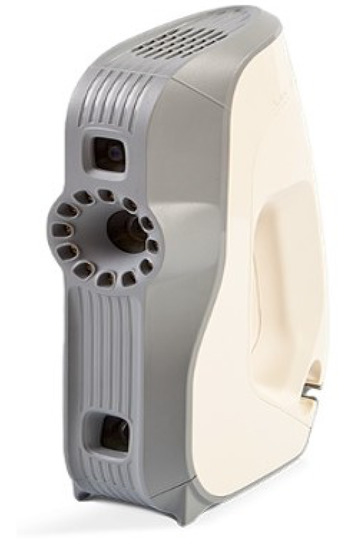
Figure 1.
Scanner view: Artec Eva.

Table 1.
Basic parameters of the Artec Eva scanner.
The data obtained after scanning were processed using the Artec Studio version 12 Professional. This is software dedicated to Artec scanners.
The petroglyph was subjected to a scanning process, Figure 2. An Artec Eva scanner was used.
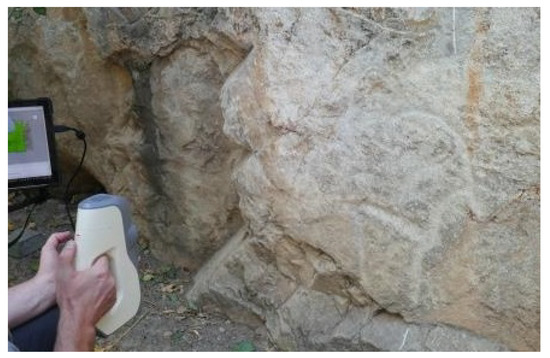
Figure 2.
Petroglyph scanning process.
The Artec Studio version 12 Professional was used for data processing. The first phase of data processing was loading the scanned objects and placing them in three-dimensional space. The loaded objects are shown in Figure 3.
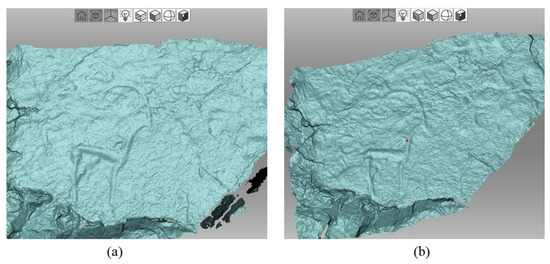
Figure 3.
Sample objects in the form of a petroglyph scan, (a) scan no. 1, (b) scan no. 2.
The superimposition of the scanned objects and their processing made it possible to obtain a 3D mesh model of the petroglyph. A number of activities based on specialised tools were used to build the mesh:
- Registration—Fine registration.
- Edition of scans—Removed artefacts; (selection tools were used, such as: Lasso selection, Cutoff-plane selection and 3D selection).
- Alignment of scans—scans were matched by specifying 3–4 pairs of characteristic points on the scans.
- Registration—Global registration.
- Fusion—Outlier removal.
- Fusion—Smooth fusion.
- Postprocessing—if there were holes, they were repaired using the Hole filling or Fix holes tools.
- Postprocessing—Mesh simplification.
- Applying texture.
The mesh model of the petroglyph generated by the program is shown in Figure 4.
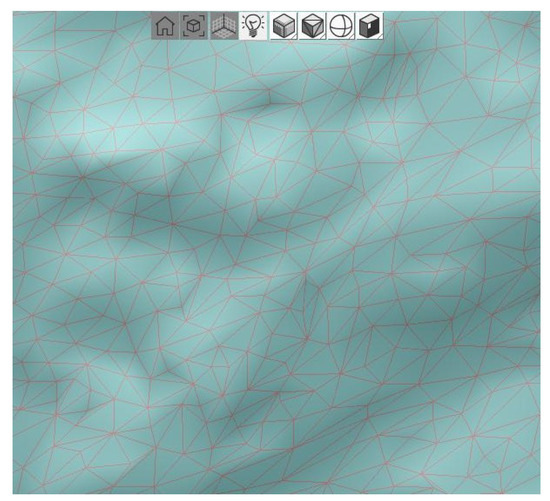
Figure 4.
An example of a mesh area of a scanned petroglyph.
The mesh model obtained from the scans had the so-called zero thickness. This was due to the fact that the object (petroglyph) was scanned only from one side—from the front. Moreover, the obtained 3D mesh model would be burdened with defects of mesh geometry. Autodesk’s 3ds Max program was used for further processing of the mesh model. With the right tools and Boolean logic operations, the missing areas of the mesh were supplemented and a fully valuable virtual object of the scanned petroglyph was obtained, Figure 5.
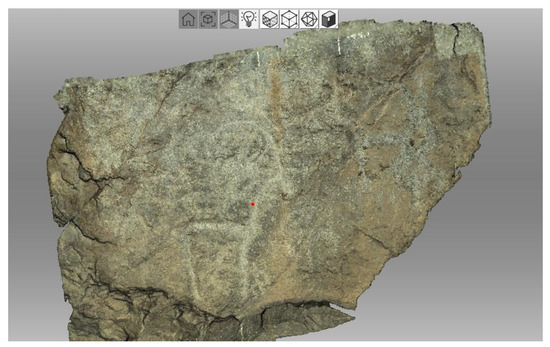
Figure 5.
View of the scanned object with a rock structure overlaid.
The created object was saved as files with extensions STL and XYZ. The examined petroglyphs were made by subtractive methods. Apart from the drawings themselves, there are many cavities in the investigated rock material. Scanning the surface provides a good quality topographic model, which has the additional consequence of transferring to digital form the grooves. The scanned objects are characterised by high surface roughness, which additionally makes it difficult to find the desired drawing. Due to the rough surface, it is not easy to identify only man-made fragments. It is assumed that the drawing is continuous, i.e., it has connection between successive fragments of the pattern being searched for. The processing consisted of preparatory stages which included:
- 1.
- Reading of the mesh model.
- 2.
- Assessment of the location of the pattern in relation to the floor plane (XY).
- 3.
- 3D transforms of point clouds (rotations around the axis X, Y, Z).
- 4.
- Removing unnecessary fragments of the model.
- 5.
- Sorting points on the y coordinate.
- 6.
- Creating a section for a given interval m < y < n.
- 7.
- Representation of the cross-section in the diagram.
- 8.
- Searching for local minima with specific properties for each cross-section (width and depth of the ‘well’).
- 9.
- Joining sections—the vicinity of the points found must be within the range (elimination of local grooves).
Algorithm 1 shows how to deal with the coordinate file (XYZ).
| Algorithm 1: Cloud data pre-processing and cross-section creation |
| Input: Coordinate file . Parameters: Parameters defining the cross-section creation step, window parameters. Output: Coordinate file .
|
The first step of the presented algorithm is to visualise the file containing the coordinates of each scanned point using the Ovito—Open Visualization Tool [18]. Preliminary evaluation of the visualized point cloud allows to determine whether a transformation around any of the X, Y or Z axes is required in order to arrange the petroglyph surface parallel to the XY plane. Another reason may be the need to reduce the point set for faster processing [19]. The next step is to remove the model fragments. Reducing the number of points shortens the processing time and speeds up acquisitions of the final solution. The selection of fragments is manual and allows to reduce the size of the model by about 70%. If a deviation is found, transformations are carried out in accordance with Formulas (1)–(3).
where R is the elementary rotation matrix in the X, Y, and Z axes, respectively, and is the rotation angle.
The coordinates of the points after the rotation around any axis will be the result of multiplying the specific R matrix by the coordinates of each of the original points. Alignment in this way allows to generate a cross-section that can be easily interpreted, because the coordinates of each successive layer do not differ significantly from the previous one. After the initial preprocessing operations, the coordinates are saved to the local database. The use of a database enables the execution of several steps of the implemented algorithm simultaneously. The database search operation is more efficient than the operation with large text files because of the ability to perform both filtering and sorting with one command. When the data are loaded into the database, the stage of selecting the model fragments with a given step according to the relationship begins:
where are coordinates of the i point, and m and n are cut-off values for a specific plane. Using an interval instead of a single value was considered, because only a few points could then meet the condition. Finally, a larger set of points belonging to several planes satisfying the inequality was analysed. A point was selected with coordinates that meet, firstly, within the examined set of points, and secondly, the y coordinate for a given set is in the range .
For each data set meeting the above relationship, the coordinates of a given point are grouped to a dependence that performs the function. The section created in this way is subjected to further analysis.
In the next step, the process of searching for at least one local minimum with specified criteria is started. The problem is not trivial due to the existing roughness and grooves visible as minor changes in the value of the z coordinate for subsequent x.
The local minimum on each of the planes is detected using a window of l values. Successive values of are checked and if a significant decrease is detected, and then a sufficiently large increase, the anomaly is considered as a minimum.
After completing the search for the minimum for a single cross-section, the coordinates of points for the layer belonging to the interval are saved (5). According to Algorithm 1, the minimum search is repeated for each layer.
After all the slices are searched for the local minimum, the proximity of these extremes on the k nearest layers is checked. The comparison of k sets of coordinates follows and in the case of a difference in the values of x within the window, a neighbourhood is found. If there is no neighbourhood, the minimum coordinates are removed from the list. This solution ensures that small grooves that are definitely not part of the pattern you are looked for are omitted. The ready set of coordinates extracted from the above algorithm is removed from the original cloud set.
5. Results
The data obtained in accordance with the description in Section 4 were used for the study.
5.1. Visualisation
Visualisation allows to determine whether and where the object of interest is located in the model. In addition, it allows to assess whether it is necessary to carry out a reduction, e.g., when the model is very large and the object sought is relatively small. An example of a complete set of points is presented in Figure 6.
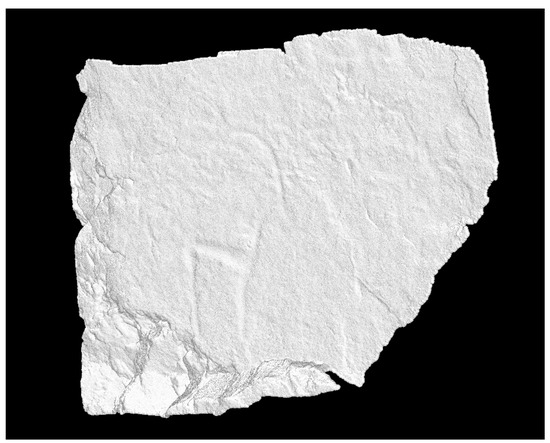
Figure 6.
Sample set of petroglyph points.
5.2. Model Reduction
The reading time of the point cloud as well as its processing depends on the size, therefore the first step after visualization is to reduce the size. It is obvious that it is impossible to get rid of the set of points located in the area of interest. Therefore, this step is completely manual. The reduced model is shown in Figure 7.
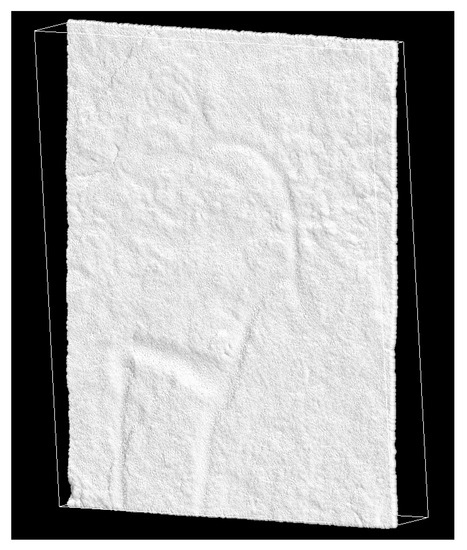
Figure 7.
The model after removing unnecessary elements.
5.3. Matrix Transformations
In order to generate a cross-section on the basis of which it is possible to find the local minimum (grooves), the model pattern should be placed parallel to the plane. Then each subsequent cross-section will not differ diametrically from the previous one. Using Formulas (1)–(4), all positions of the points should be recalculated in such a way as to achieve the parallelism of the planes. The above example clearly shows a deviation in the X axis. The angle of rotation is selected empirically. The model before and after the rotation around the X axis is shown in Figure 8.
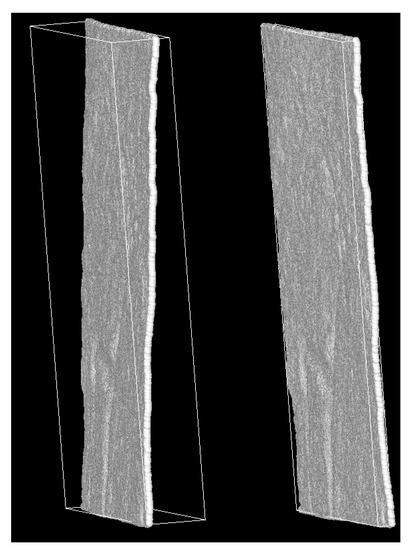
Figure 8.
The model before and after rotation around the X axis.
5.4. Cross-Section
After the model is properly positioned, the cross-section is created along the Y axis. Each of the cross-sections is a relationship that consists of several layers of the Y direction. This is due to the fact that for a given y coordinate there are not enough points to determine the local minimum. An example of a cross-section is shown in Figure 9. The points selected from the set must therefore belong to the interval that satisfies the inequality (5). Figure 9 clearly shows two drops in values which are responsible for the engraved ‘legs’ of the goat shown on the tested rock.
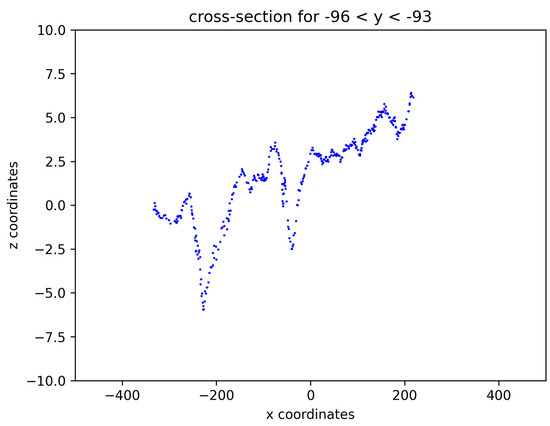
Figure 9.
The model cross-section for (−96, −93).
5.5. Searching Minimum
The search for a local minimum is a key element of the work presented. It is assumed that in each of the cross-section layers there must be at least one minimum in the pattern region. The lack of a local extreme is interpreted as the lack of a pattern in a given layer, similarly an occurrence on a single section only. The algorithm analyses k consecutive z values in the window according to the x-order. When a decrease and an increase are detected, the data are temporarily saved to the table. After the search is completed, for a given section, local minima of the specified width and depth are selected, while others are ignored. The extreme dimensions must be consistently repeated on successive layers in the vicinity of detection. Such a procedure allows to reduce the risk of recognising a natural groove as part of the pattern. In the case of extensive natural engravings located on the surface the algorithm may consider them as part of the pattern.
5.6. Pattern Removal
For the obtained set of points classified as an element of the formula, the operation of subtracting from the main model is performed. The highlighting of the petroglyph is done by iterative removal of points. The removal takes place in several iterations, which causes points to be mainly removed from the vicinity of detected extremes. As a result, an in-depth model was obtained, which shows human activity more clearly than before. The effect of the algorithm’s operation is shown in Figure 10.
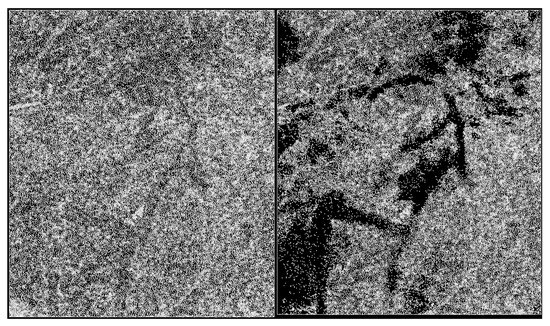
Figure 10.
The model before and after highlighting the detected pattern.
Extracted points belonging to the pattern can be successfully used to create a new model that is a negative for a rock pattern (cast), e.g., for use in 3D printing. After applying the algorithm, the place and shape of the pattern being searched for was clearly shown, which was difficult to see before.
6. Discussion
The 3D scanning process of petroglyphs allowed for detailed mapping of the object in the virtual world. The 3D spatial inventory provides a complete set of data on the monument, which in turn can be used for further work. It is an excellent solution for scientists, archaeologists and historians who would like to conduct research. The prepared 3D model of the object will be perfect as a basis for creating reconstruction or revitalisation projects. There are many reasons why 3D scanning should become a widely used method of documenting in the protection of monuments:
- 3D scanning poses no risk to scanned objects. 3D scanners look like cameras and the equipment never touches the object or emits harmful radiation. This technology deserves the name of a fully non-invasive method of examining historic buildings.
- 3D scanning offers an extremely accurate representation of the object. Mapping unusual and complex shapes with the help of documentation made by hand would be impossible. In addition, 3D scanners are able to document the colours and textures of the scanned surfaces, which makes them useful also in the case of the presence of paint layers, which is very important in the case of petroglyphs.
- While scanning petroglyphs, data related to the surrounding space, e.g., the shape of rocks, is simultaneously collected [20].
- 3D scanning is fast and efficient, especially compared to traditional measurement and documentation methods. Making a 3D model of a petroglyph, without laser scanning, but only on the basis of photos and traditional measurements, also involves a huge expenditure of time and work. However, the time needed to obtain a point cloud of even a very complex object is several minutes [21,22].
- 3D scanning of petroglyphs is considered to be the most accurate monument recording technology that we can create today.
- Virtual objects can be used as exhibits to create virtual museums. These types of exhibitions are increasingly used in the field of museology.
- 3D scans of monuments and cultural heritage are an invaluable aid for museums that want to present their exhibits online. Regardless of their command of the relevant language or their knowledge, recipients can discover the common cultural heritage in an interesting and modern way from anywhere in the world.
- Digital mapping of historic objects also gives the opportunity to assess the level of their damage. This may prove invaluable especially in the case of monuments that have been destroyed or devastated.
- The 3D scans were suitable for further processing and were not rejected by the software due to too many errors.
- Processing data from a point cloud to obtain a mesh model of a petroglyph using Artec Studio 12 is a time-consuming operation and requires quite a lot of computing power [23].
- The model highlighting algorithm can be used for preparatory operations, e.g., before 3D printing. It allows to better visualise the pattern in the digital model.
In the models used, the number of points in the cloud originally exceeded 250 and 300 thousand (file sizes: 10.8 MB and 12.6 MB), respectively; after processing it was reduced to about 70 thousand (reduction rate is over 70%). An interesting functionality of 3D scanning processes is also modern education and promotion, where visualisations of historic architecture in virtual reality are used to disseminate knowledge about monuments. The development of knowledge and active participation in getting to know the cultural heritage contributes to the protection of monuments for future generations [24].
7. Conclusions
The use of 3D scanning technology allows to easily transfer any real object to the virtual three-dimensional world. Due to the high detail of measurements, it can also be used to carry out 3D building inventories. Recent years have seen the development of the field of museology, where virtual museums are increasingly used. Interestingly, they are becoming more and more popular. No technology can replace personal contact with works of art. Personal contact with a monument is often related to the atmosphere of the surroundings and the people of a given region. Scanned historic objects can be recreated as replicas using 3D printing technology. Such replicas of monuments are created for blind people who cannot touch the monument and get to know it. 3D scanners are perfect for archaeological works [14,25]. It is possible to carry out with them extremely accurate scanning of earth layers at archaeological sites. Removing layers of earth and working with monuments irretrievably destroys their arrangement. The way the objects are arranged in the ground gives a lot of information about the find. A digital record of such posts helps to save this information for return [26]. The paper presents the preliminary application of the algorithm highlighting petroglyph pattern. The presented example shows the point cloud processing and the final result. Future works assume the improvement of the algorithm in terms of better detection of points belonging only to the pattern being searched and omitting the remaining objects.
Author Contributions
Conceptualization, M.M. and S.K.; methodology, M.M., S.K. and P.W.; software, P.W. and S.K.; validation, M.M., S.K. and P.W.; formal analysis, S.K.; investigation, P.W.; resources, M.M.; data curation, P.W.; writing—original draft preparation, P.W., S.K. and M.M.; writing—review and editing, M.M., S.K. and P.W.; visualization, S.K.; supervision, M.M.; project administration, M.M. All authors have read and agreed to the published version of the manuscript.
Funding
This article has been supported by the Polish National Agency for Academic Exchange under Grant No. PPI/APM/2019/1/00004 titled “3D DIGITAL SILK ROAD”.
Institutional Review Board Statement
Not applicable.
Informed Consent Statement
Not applicable.
Data Availability Statement
The dataset created during the study can be found on the website: https://cs.pollub.pl/zasoby/?lang=en (accessed on 16 December 2021).
Conflicts of Interest
The authors declare no conflict of interest.
References
- Beckensall, S.; Laurie, T. Prehistoric Rock Art of County Durham, Swaledale and Wensleydale, 1st ed.; CBD: Beckenham, UK, 1998. [Google Scholar]
- Beckensall, S.; Laurie, T. Prehistoric Rock Art in Northumberland, 1st ed.; CBD: Beckenham, UK, 2001. [Google Scholar]
- Hawass, Z. International Journal of Cultural Property 4.1. In The Egyptian Monuments: Problems and Solutions; UNESCO: Paris, France, 2007; pp. 154–196. [Google Scholar]
- Hawass, Z. Can the Sphinx Be Saved? Archaeology 1994, 47, 42–43. [Google Scholar]
- Amenta, N. Surface Reconstruction Encyclopedia of Algorithms; Springer: New York, NY, USA, 2008; pp. 1–5. [Google Scholar]
- Ronald, M. The Prehistoric Rock Art of Galloway and the Isle of Man, 1st ed.; Blandford Press: London, UK, 1979. [Google Scholar]
- Kęsik, J.; Montusiewicz, J.; Żyła, K. Low-cost 3D Scanning Methods as Tools for Virtual Heritage Expositions. Meas. Autom. Control 2014, 60, 664–667. [Google Scholar]
- Pereira, F.G.; Martínez, J.C.; Lourenço, A.B. Virtual Restoration of a XVIII Century Sculpture. Res. Cent. Sci. Technol. Arts 2009, 3, 4–13. [Google Scholar]
- Castango, R. Il Restauro si fa in 3D Fablab di Parma: “Le Imprese ci Aiutino”. La Rivoluzione Dello Spazio 3D. 2015. Available online: http://parma.repubblica.it (accessed on 29 October 2021).
- Kęsik, J.; Montusiewicz, J.; Kayumov, R. An approach to computer-aided reconstruction of museum exhibits. Adv. Sci. Technol. Res. J. 2017, 11, 87–94. [Google Scholar] [CrossRef] [Green Version]
- Zeppelzauer, M.; Georg, P.; Seidl, M.; Reinbacher, C.; Schulter, S.; Breiteneder, C.; Bischof, H. Interactive 3D Segmentation of Rock-Art by Enhanced Depth Maps and Gradient Preserving Regularization. J. Comput. Cult. Herit. 2016, 9, 19. [Google Scholar] [CrossRef]
- Hedman, F. Improved Visualization of Rock Carvings. Bachelor’s Thesis, Uppsala University, Uppsala, Sweden, 30 November 2016. [Google Scholar]
- Horn, C.; Pitman, D.; Potter, R. An evaluation of the visualisation and interpretive potential of applying GIS data processing techniques to 3D rock art data. J. Archaeol. Sci. Rep. 2019, 27, 13. [Google Scholar] [CrossRef]
- Comes, R.; Buna, Z.; Badiu, I. Creation and Preservation of Digital Cultural Heritage Journal of Ancient History and Archeology. World Sci. Publ. 2008, 1, 150–156. [Google Scholar]
- Berndt, R.; Buchgraber, G.; Havemann, S.; Settgast, V.; Fellner, D. Publishing Workflow for Cultural Heritage Artifacts from 3D Reconstruction to Internet Presentation. In Digital Heritage, Proceedings of the Euro-Mediterranean Conference, Lemessos, Cyprus, 8–13 November; Springer: Berlin/Heidelberg, Germany, 2010; pp. 166–178. [Google Scholar]
- Li, R.; Luo, T.; Zha, H. 3D Digitization and Its Applications in Cultural Heritage. In Digital Heritage, Proceedings of the Euro-Mediterranean Conference, Lemessos, Cyprus, 8–13 November; Springer: Berlin/Heidelberg, Germany, 2010; pp. 381–388. [Google Scholar]
- Pavlidis, G.; Koutsoudis, A.; Arnaoutoglou, F.; Tsioukas, V. Methods for 3D Digitization of Cultural Heritage. J. Cult. Herit. 2007, 8, 93–98. [Google Scholar] [CrossRef] [Green Version]
- Stukowski, A. Visualization and analysis of atomistic simulation data with OVITO—The Open Visualization Tool. Model. Simul. Mater. Sci. Eng. 2010, 18, 015012. [Google Scholar] [CrossRef]
- Sitnik, R.; Mączkowski, G.; Krzesłowski, J. Calculation Methods for Digital Model Creation Based on Integrated Shape, Color and Angular Reflectivity Measurement; Springer: Berlin/Heidelberg, Germany, 2010; pp. 13–27. [Google Scholar]
- Toshew, Y.E.; Hieu, L.C.; Stefanova, L.P.; Tosheva, E.Y.; Zlatov, N.B.; Dimov, S.T. Reverse Engineering and Rapid Prototyping for new orthotic devices. In Intelligent Producion Machines and Systems; Elsevier: Amsterdam, The Netherlands, 2005. [Google Scholar]
- Montusiewicz, J.; Milosz, M.; Kayumov, R. 3D digital technologies in the practical training of archaeologists. In Proceedings of the 10th International Technology, Education and Development Conference (INTED 2016), Valencia, Spain, 7–9 March 2016; pp. 7451–7460. [Google Scholar]
- Liy, Y.; Pottmann, H.; Wang, W. Constrained 3D shape reconstruction using a combination of surface fitting and registration. Comput. Aided Des. 2006, 38, 572–583. [Google Scholar] [CrossRef]
- Raja, V.; Fernandes, K.J. Reverse Engineering. In An Industrial Perspective; Springer: London, UK, 2008. [Google Scholar]
- Montusiewicz, J.; Czyż, Z.; Kayumov, R. Selected methods of making three-dimensional virtual models of museum ceramic objects. Appl. Comput. Sci. 2015, 11, 51–65. [Google Scholar]
- Patay-Horvath, A. The virtual 3D reconstruction of the east pediment of the temple of Zeus at Olympia an old puzzle of classical archaeology in the light of recent technologies. Digit. Appl. Archaeol. Cult. Herit. 2014, 1, 12–22. [Google Scholar] [CrossRef]
- Ramandeep, S.; Ashish, S.; Sneh, A.; Britty, B. Validation of reverse-engineered and additive-manufactured microsurgical instrument prototype. Surg. Innov. 2016, 23, 606–612. [Google Scholar]
Publisher’s Note: MDPI stays neutral with regard to jurisdictional claims in published maps and institutional affiliations. |
© 2022 by the authors. Licensee MDPI, Basel, Switzerland. This article is an open access article distributed under the terms and conditions of the Creative Commons Attribution (CC BY) license (https://creativecommons.org/licenses/by/4.0/).